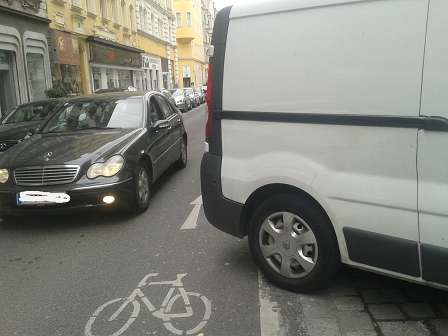Erstellt am: 31. 3. 2017 - 19:44 Uhr
Vienna's Cycling Infrastructure is "Chaotic"
This weekend Vienna hosts Europe's biggest bicycle festival; the Argus Bike Festival. Held in front of the Vienna town hall on Saturday and Sunday, it’s a celebration of the myriad joys of cycling. It will feature a pump track, the smallest velodrome in the world, and an E-bike parcours.
A Laggard
But while Vienna is a European leader in celebrating cycling it is far from a European leader in terms of getting people on their bikes. In fact, Vienna is even a laggard with in Austria. While cycle participation in Innsbruck is as high as 24 percent, in Vienna it is just 7 percent.

Christian Gemmato
This is a hugely important issue. Cycling is also seen as a key factor in combatting air pollution, much of it caused by diesel-powered transportation.
This toxic smog is said to cause 600,000 premature deaths in Europe every year costing our economies 1.6 trillion US-Dollars a year.
"Nice but chaotic"
Despite a deepening knowledge of this the devastating health time-bomb, despite various pro-cycling marketing campaigns, despite Austria’s climate commitments (transportation is Europe’s number 1 emissions growth area) and despite an obesity and diabetes epidemic related to inactivity, despite a colourful, engaged and charismatic activist scene, Austria’s capital can’t seem to make that cycle-friendly breakthrough.

Daniel Böhm
Mikael Colville-Andersen, a guru of bike infrastructure, is from the Danish design group Copenhagenize, based in the Danish capital where 55 percent of all Copenhageners cycle to and from work. He damns the bike infrastructure in Vienna with faint praise calling it “nice but so chaotic”. He says, if Vienna is serious about rivalling more attractive cycling cities, it has to make space for and find the budget for better cycling infrastructure.
His main message is this: appealing to people to change their habits for the benefit to themselves and wider society is not enough. It needs strong political leadership.
Prove it is easy and fast!
“We can talk all day about riding a bike because it is good for you and it will save a polar bear and the planet,” says the plain-speaking Dane. “That’s bullshit. Nobody cares. We’re boring, conservative Homo sapiens. The only way that makes people change their habits is if you can prove to people that the bicycle is faster way of getting from A to B and an effortless way to get from A to B.”

Chris Cummins
Colville-Andersen calls the targets for improvements “embarrassing.” Vienna has raised cycle participation from under to 5 percent in 2011 to its current level by adding hundreds of bike lanes and 10,000 new bike parking spaces. But much of the bike lanes, criticise activists, are just white lines painted in the road and are not attractive.
"Bad design"
“You have a latent demand for more infrastructure,” says Colville Andersen. “You have lot of smart city people in Vienna who know the bike works as transport but they are not riding in the numbers you want because the infrastructure is so badly designed.”

Chris Cummins
The Danish designer calls on Vienna to show political courage and ambition: “Vienna is trying to move from 6 percent to 9 percent and isn’t even managing that. Meanwhile Minneapolis, where it is minus 30 degrees in the winter, has gone from pretty much zero to 6 percent in just 4 years. Seville has gone from 0.2 percent to 7 percent in just 4 years. There are cities that are doing this fast.”
A Top Down Solution
Ground-roots activism is important, he says, in keeping “the chattering going” and the pressure on but at the end of the day this issue needs a “top-down” solution: “In every city on the planet where this has been done effectively in the past decade it has been a politician that has had the vision, realized that it makes sense and is cost-effective and then implements that vision.”

Chris Cummins
Colville-Andersen says, that he believes sooner or later all major European cities will follow his advice and dedicate the amount of resources necessary to create a healthy and attractive cycling environment.
“There is a momentum. It is unstoppable. In a few years cities that are not making their streets cycle friendly will find it really embarrassing. This is the new normal.”
It is just a question of which cities arrive there first.


